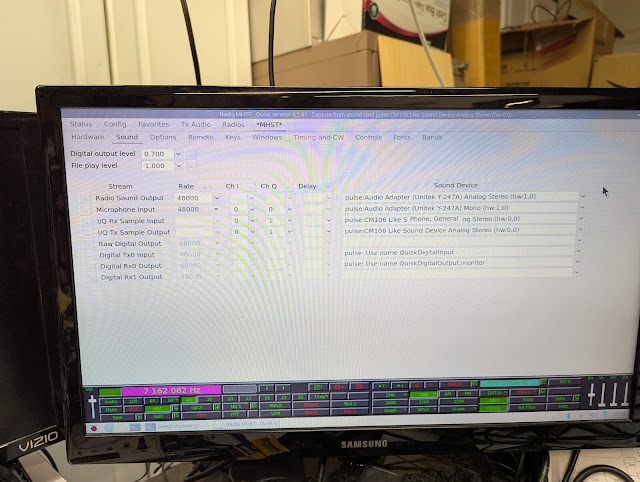Today we start with an updated Block Diagram of the MHST (Minimalist Homebrew SDR Transceiver).
Let us start by tracing the Receive and Transmit Paths. Essentially the Received signal starts at the Analog front end passing through the TR Relay into the Main Board. The received signal is first amplified by the Steerable Amp and then passes this signal stream on to the Band Pass Filter.
From here a simple FT-37-43 transformer splits the received RF signal into two RF signal paths passing one each to the RF input side of the two ADE-1's. There in each ADE-1 a Quadrature LO signal introduced from the Pi Pico converts the RF signals into two audio streams (In Phase and Quadrature -- I & Q).
The next step is the Sound Card which processes the two audio streams into the RPI5 for signal processing and displaying the signals on the HDMI Screen and sending recovered audio to a Headphone/Mic Sound card dongle.
The Optimal Shop Sound Card has both a stereo Line Input Port and a Stereo Output Port. Thus, in it is in line on Both Transmit and Receive. The ADE-1 was chosen over the Tayloe encoder/decoder because they are inherently bi-directional, require no power and rely on the RPi5 to either direct the units to receive signals or to transmit signals.
On transmit the Mic Portion of the Headset/Mic dongle sends the mic audio to the RPi5 where it is processed to create a transmit I and Q audio stream and passed those on to the ADE-1s for up conversion at the operating frequency. Our magic FT-37-43 splitter is now a signal combiner and then on to the BPF and Steerable Amp. From there on to the normal RF electronics.
So far, the Receive path is working really well. Now a Caveat Emptor! This is a minimalist radio and comparing this to a FLEX 6700 or Apache Anon is like comparing a Maserati to our venerable 57 VW Beetle. Both backseats will accommodate Mary Jo but no question a bit more comfortable in the Maserati.
The Transmit side does not work! The RPi5 and QUISK software works with other radios. The ADE-1 Board form factor is a proven configuration and if it works on receive it will work on transmit.
So, undeniably the F^3 (Fickle Finger of Fate) points to the VWS software package embedded in the QUISK directory. Keep in mind the VWS package was developed for a SDR RECEIVER project and not initially seen as a transceiver. So not a shortcoming in the original software as it does work on Receive and quite well.
So, some person with the skill set to modify the VWS package is the key. I just don't have that capability in my tool kit. In the QUISK Menu is a page to configure the Optimal Shop Sound Card for the Receive and Transmit task. There are some blanks on that card that relate to transmitting which leads you to conclude that data that is missing to command the Mic signal stream into the RPI5.
Observe the two entries marked I/Q Rx Sample Input and Tx Sample Output where the Baud Rate is blank -- flashing light guys!
This shot shows the Sound Device List and a small arrow to the very right enables a drop-down menu of selections. The 1st two entries are on a menu and select the headset/mic dongle. Lines 3 and 4 are blank and I physically typed in the Optimal Shop Designation. There should be sound devices to select for these blanks. It is the same issue with Windows 10 where you type in "Primary".
Finally, the last two entries have menu selections. So, the lack of a data selection entry for line 4 is the most likely the transmit issue and it is something in the software specific to the VWS package as it was not intended for transmitting.
A huge mountain peak has been conquered with the Pi Pico to control the Quadrature LO via QUISK. This opens the door to any I/Q arrangement whether it be the Tayloe or ADE-1, SBL-1 or TUF-1 device. Adjusting the code for the Transmit function will make the MHST a working radio.
Them that know can make it go.
73's
Pete N6QW


